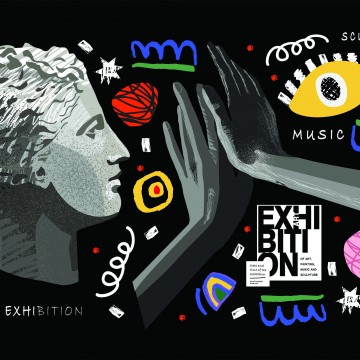

Year 11 Art: Making and Exhibiting Units 1 and 2
Overview
In this subject, you will explore a range of art materials, techniques and processes to further develop your skills to create and present artworks. You will also learn how to apply an effective art-making process in a visual arts journal while developing your artworks, as well as analyse and research a range of artworks and art exhibitions.
Who is it for?
Art Making and Exhibiting is for students who love exploring art materials, making artworks and thinking creatively. If you are interested in developing your skills as an artist; presenting artworks to audiences; making, attending and planning exhibitions, or if you wish to have a career in a creative field, then this subject is suited to you.
You may also like to do this subject if you have a passion for museums, galleries, history and culture, or if you would like to work with cultural heritage, artworks, artists and cultural events.
What do you do?
In Units 1 & 2, you will explore a range of art forms, materials, techniques and processes in a visual arts journal in order to make and present artworks for exhibitions. You will also research a range of artists, artworks and art exhibitions to inform your own art-making and to create and plan exhibitions. A range of artist workshops and educational talks for specific exhibition case studies will also be covered.
What skills do you need?
You should have some or all of the following:
- manual art-making skills
- digital art-making skills
- creative thinking skills
- writing and communication skills
- observational and listening skills
- the ability to be open to new ideas and ways of thinking and seeing.
What skills do you develop?
In Art Making and Exhibiting, Units 1 & 2 you will strengthen and broaden your art-making, curatorial, analytical and creative thinking skills, as well as your interpersonal and communication skills through reflection, discussion and critiques.
Requirements
To be successful in this subject you will need access to a space to work creatively, as well as a camera, computer and a printer. You will also need a range of art materials and equipment including:
- an A3 visual diary
- lead pencils (HB, 2B, 4B, 6B)
- fineliners and markers
- acrylic paints
- brushes
- basic stationery items: ruler, glue, scissors, sharpener, eraser, compass
- camera or phone for documentation
- other art materials as required.
Things to think about
Working in your visual art journal is a weekly process for successful results in this subject. Students should be regularly documenting and reflecting upon their explorations of ideas, subject matter and materials independently for a minimum of 3 hours per week.
Theory is also an important part of this course. Students can expect to commit to a minimum of 2 hours per week to cover the theoretical content of this course.
Things you can do now
Make a space for art-making and begin to collate your materials, ready for art-making and exploration.
Visit art galleries and exhibitions, and begin keeping a journal of the things that you have seen. (A scrapbook, or even a digital diary or blog, for example)
Start taking notes and photographs of ideas that you find interesting for potential inspiration and subject matter.
Contact the subject contact person to ask any questions or if you need any further clarification about anything relating to this subject, or to discuss which Visual Art subject is more suited to you.
Things to have a look at
Top Arts 2023, National Gallery of Victoria
Explore the Top Art 2023 exhibition, artworks, and folios of some of Victoria’s top Visual Arts students.
How curators went from caretakers to art stars
Curation is everywhere these days, but what is a curator anyway? Why do they matter? And what does curating actually mean?
What is Art For?
Why make, present and view art? Here are some insights and interesting views on this question.